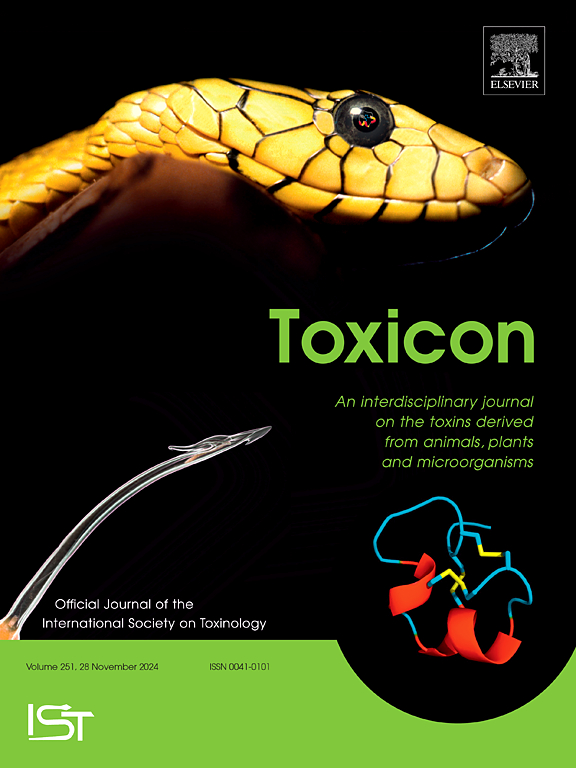Raptors without resistance: No evidence for endogenous inhibition of rattlesnake venom metalloproteinases in a Great Plains raptor assemblage
IF 2.6
4区 医学
Q2 PHARMACOLOGY & PHARMACY
引用次数: 0
Abstract
Snake venoms are complex biochemical secretions under strong selection for prey subjugation, and venoms are tightly linked to the biotic communities that snakes inhabit. Physiological adaptations for venom resistance have been identified in various snake prey species, but fewer snake predators, with research in this area largely biased towards mammalian species. Fewer investigations have assayed for the presence of resistance mechanisms in avian systems. Birds of prey (hereafter “raptors”; orders Accipitriformes, Falconiformes, and Strigiformes) represent major sources of predation for snakes. Raptor dietary habits range from snake specialists to non-snake feeders, and this continuum of snake predation frequency among species creates the ideal system in which to explore the presence and strength of venom resistance. We assayed sera from a suite of Great Plains raptors against snake venom metalloproteinases (SVMPs) of the Prairie rattlesnake (Crotalus v. viridis) to test the general hypotheses that 1) raptor sera will display elevated SVMP inhibition compared to a naïve avian model (domestic chicken; Gallus gallus) and 2) raptor species with high levels of rattlesnake predation will more effectively inhibit SVMP activity than those that are not known to feed on rattlesnakes. We found that raptors do possess elevated SVMP inhibition in comparison to a naïve avian model, but this level of inhibition remains low and is unlikely to be biologically significant in detoxifying venoms. We found no evidence suggesting that inhibitory potential of different raptor sera corresponds to the level of rattlesnake predation associated with each species. The widespread lack of SVMP inhibition in diverse raptors underscores the complexity of venom resistance dynamics in natural systems and further suggests that physiological venom resistance mechanisms may be poorly developed in birds more broadly.

没有抵抗的猛禽:没有证据表明内源性抑制响尾蛇毒液金属蛋白酶在大平原的猛禽组合
蛇毒是一种复杂的生化分泌物,在强烈的选择下被猎物征服,毒液与蛇栖息的生物群落密切相关。对毒液抗性的生理适应已经在各种蛇的猎物物种中被发现,但在蛇的捕食者中较少,这一领域的研究主要集中在哺乳动物物种上。较少的调查分析了禽流感系统中存在的耐药机制。猛禽(以下简称“猛禽”);鹰形目、鹰形目和隐形目)是蛇的主要捕食对象。迅猛龙的饮食习惯从专吃蛇到不吃蛇,这种连续的蛇捕食频率在物种之间创造了一个理想的系统,在这个系统中,探索毒液抗性的存在和强度。我们分析了一组大平原猛禽血清对草原响尾蛇(Crotalus v. viridis)蛇毒金属蛋白酶(SVMPs)的抑制作用,以验证以下假设:1)与naïve鸟类模型(家鸡;与那些不以响尾蛇为食的物种相比,高水平捕食响尾蛇的野鸡(Gallus Gallus)和猛禽(raptor)物种会更有效地抑制SVMP的活动。我们发现,与naïve鸟类模型相比,猛禽确实具有更高的SVMP抑制,但这种抑制水平仍然很低,在解毒过程中不太可能具有生物学意义。我们没有发现任何证据表明不同的猛禽血清的抑制潜能对应于响尾蛇与每个物种的捕食水平。在各种猛禽中普遍缺乏SVMP抑制强调了自然系统中蛇毒抗性动态的复杂性,并进一步表明生理蛇毒抗性机制可能在更广泛的鸟类中发育不良。
本文章由计算机程序翻译,如有差异,请以英文原文为准。
求助全文
约1分钟内获得全文
求助全文
来源期刊

Toxicon
医学-毒理学
CiteScore
4.80
自引率
10.70%
发文量
358
审稿时长
68 days
期刊介绍:
Toxicon has an open access mirror Toxicon: X, sharing the same aims and scope, editorial team, submission system and rigorous peer review. An introductory offer Toxicon: X - full waiver of the Open Access fee.
Toxicon''s "aims and scope" are to publish:
-articles containing the results of original research on problems related to toxins derived from animals, plants and microorganisms
-papers on novel findings related to the chemical, pharmacological, toxicological, and immunological properties of natural toxins
-molecular biological studies of toxins and other genes from poisonous and venomous organisms that advance understanding of the role or function of toxins
-clinical observations on poisoning and envenoming where a new therapeutic principle has been proposed or a decidedly superior clinical result has been obtained.
-material on the use of toxins as tools in studying biological processes and material on subjects related to venom and antivenom problems.
-articles on the translational application of toxins, for example as drugs and insecticides
-epidemiological studies on envenoming or poisoning, so long as they highlight a previously unrecognised medical problem or provide insight into the prevention or medical treatment of envenoming or poisoning. Retrospective surveys of hospital records, especially those lacking species identification, will not be considered for publication. Properly designed prospective community-based surveys are strongly encouraged.
-articles describing well-known activities of venoms, such as antibacterial, anticancer, and analgesic activities of arachnid venoms, without any attempt to define the mechanism of action or purify the active component, will not be considered for publication in Toxicon.
-review articles on problems related to toxinology.
To encourage the exchange of ideas, sections of the journal may be devoted to Short Communications, Letters to the Editor and activities of the affiliated societies.
 求助内容:
求助内容: 应助结果提醒方式:
应助结果提醒方式:


